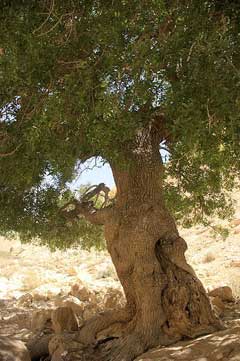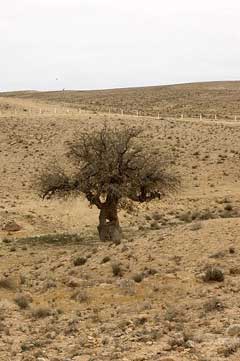 |
|
http://commons.wikimedia.org/wiki/User:Eitan_f |
 |
| http://commons.wikimedia.org/wiki/User:Eitan_f |
Translate this page:
Summary
Bloom Color: Green. Main Bloom Time: Mid spring. Form: Oval, Rounded, Spreading or horizontal, Vase.
Physical Characteristics

 Pistacia atlantica is a deciduous Tree growing to 20 m (65ft 7in) at a slow rate.
Pistacia atlantica is a deciduous Tree growing to 20 m (65ft 7in) at a slow rate.
See above for USDA hardiness. It is hardy to UK zone 9. The species is dioecious (individual flowers are either male or female, but only one sex is to be found on any one plant so both male and female plants must be grown if seed is required). . The plant is not self-fertile.
Suitable for: light (sandy) and medium (loamy) soils and prefers well-drained soil. Suitable pH: mildly acid, neutral and basic (mildly alkaline) soils. It cannot grow in the shade. It prefers dry or moist soil.
UK Hardiness Map
US Hardiness Map
Synonyms
Plant Habitats
Woodland Garden Secondary; Sunny Edge;
Edible Uses
Edible Parts: Fruit Oil
Edible Uses: Gum Oil
Fruit - raw[61, 177]. A turpentine flavour[183]. The fruit is about 8mm long and 6mm wide and contains a single seed[200]. An excellent edible oil is obtained from the seed[183].
References More on Edible Uses
Medicinal Uses
Plants For A Future can not take any responsibility for any adverse effects from the use of plants. Always seek advice from a professional before using a plant medicinally.
Antiseptic
Antiseptic[93].
References More on Medicinal Uses
The Bookshop: Edible Plant Books
Our Latest books on Perennial Plants For Food Forests and Permaculture Gardens in paperback or digital formats.

Edible Tropical Plants
Food Forest Plants for Hotter Conditions: 250+ Plants For Tropical Food Forests & Permaculture Gardens.
More

Edible Temperate Plants
Plants for Your Food Forest: 500 Plants for Temperate Food Forests & Permaculture Gardens.
More

More Books
PFAF have eight books available in paperback and digital formats. Browse the shop for more information.
Shop Now
Other Uses
Dye Gum Ink Oil Resin Rootstock Tannin Wood
Used as a rootstock for P. vera, the pistachio nut[183]. A resin is obtained from the tree[117]. No more details. A gum is obtained from the tree. It is used medicinally[93]. It is possible that the gum and the resin are the same thing[K]. Tannin is obtained from galls that develop on the tree as a result of a fungus. It is used to make an ink and a dye[61]. The leaves contain 22.2% tannin[223]. The wood is useful[46].
Special Uses
References More on Other Uses
Cultivation details
Requires a sunny position in a deep well-drained light soil[200]. Succeeds in dry soils. This species is not very cold-hardy in Britain[1], though it can succeed outdoors in the mildest areas of the country. This plant is sometimes grown near P. vera, the pistachio, as a pollinator[183]. Any pruning that needs to be done is best carried out in the spring[238]. Plants are prone to fungal root rots[200]. Dioecious, male and female plants must be grown if seed is required. Special Features:Not North American native, Naturalizing, Inconspicuous flowers or blooms.
References Carbon Farming Information and Carbon Sequestration Information
Temperature Converter
Type a value in the Celsius field to convert the value to Fahrenheit:
Fahrenheit:
The PFAF Bookshop
Plants For A Future have a number of books available in paperback and digital form. Book titles include Edible Plants, Edible Perennials, Edible Trees,Edible Shrubs, Woodland Gardening, and Temperate Food Forest Plants. Our new book is Food Forest Plants For Hotter Conditions (Tropical and Sub-Tropical).
Shop Now
Plant Propagation
Pre-soak the seed for 16 hours in alkalized water[78], or for 3 - 4 days in warm water[1], and sow late winter in a cold frame or greenhouse[78, 113]. Two months cold stratification may speed up germination, so it might be better to sow the seed in early winter[113]. The germination is variable and can be slow. Prick out the seedlings into individual pots when they are large enough to handle and grow on the plants for at least their first winter in a greenhouse. Plant out into their permanent positions in early summer and consider giving some protection from winter cold for their first year or two outdoors[K]. Cuttings of half-ripe wood from juvenile trees, July in a frame[113]. Layering.
Other Names
If available other names are mentioned here
Native Range
TEMPERATE ASIA: Saudi Arabia, Afghanistan, Cyprus, Egypt (Sinai), Iran, Iraq, Israel, Jordan, Lebanon, Syria, Turkey, Armenia, Azerbaijan, Georgia TROPICAL ASIA: India (Himachal Pradesh), Pakistan EUROPE: Ukraine (Krym), Greece AFRICA: Spain (Canarias), Algeria (north), Libya (north), Morocco, Tunisia
Weed Potential
Right plant wrong place. We are currently updating this section.
Please note that a plant may be invasive in one area but may not in your area so it's worth checking.
Conservation Status
IUCN Red List of Threatened Plants Status :

Growth: S = slow M = medium F = fast. Soil: L = light (sandy) M = medium H = heavy (clay). pH: A = acid N = neutral B = basic (alkaline). Shade: F = full shade S = semi-shade N = no shade. Moisture: D = dry M = Moist We = wet Wa = water.
Now available:
Food Forest Plants for Mediterranean Conditions
350+ Perennial Plants For Mediterranean and Drier Food Forests and Permaculture Gardens.
[Paperback and eBook]
This is the third in Plants For A Future's series of plant guides for food forests tailored to
specific climate zones. Following volumes on temperate and tropical ecosystems, this book focuses
on species suited to Mediterranean conditions—regions with hot, dry summers and cool, wet winters,
often facing the added challenge of climate change.
Read More
Expert comment
Author
Desf.
Botanical References
1150200
Links / References
For a list of references used on this page please go here
Readers comment